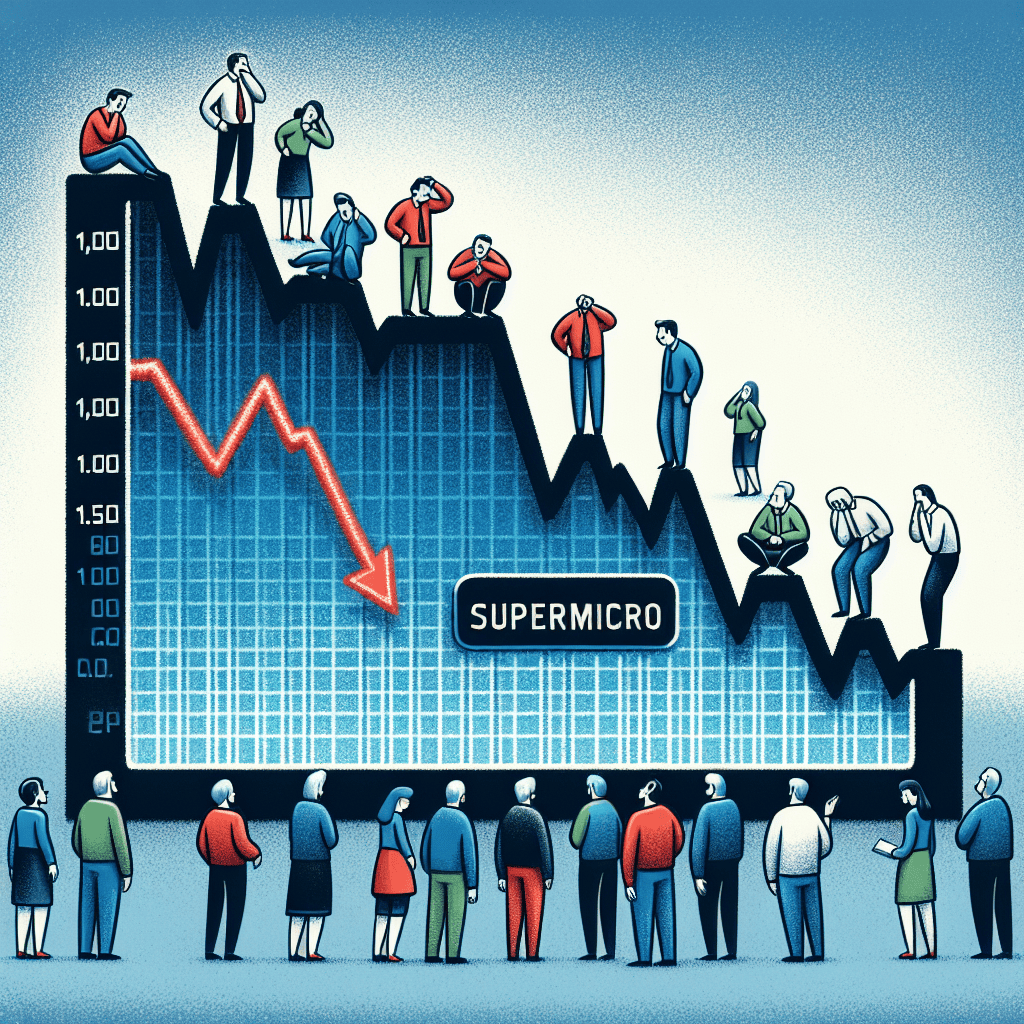“Supermicro Stock: Seize the Dip or Heed the Warning?”
Introduction
Supermicro, a prominent player in the high-performance computing and server solutions market, has recently experienced another dip in its stock value, prompting investors to reassess their positions. This fluctuation raises a critical question: does this present a buying opportunity for those looking to capitalize on potential undervaluation, or is it a cautionary tale that signals deeper issues within the company or the broader market? As investors weigh the potential risks and rewards, understanding the factors contributing to the stock’s volatility, including market trends, company performance, and industry dynamics, becomes essential in making informed investment decisions.
Analyzing Supermicro’s Recent Stock Performance: Key Factors Behind the Dip
Supermicro’s recent stock performance has captured the attention of investors and analysts alike, as the company’s shares have experienced a notable dip. This decline has prompted a closer examination of the underlying factors contributing to the downturn, raising the question of whether this presents a buying opportunity or serves as a cautionary tale for potential investors. To understand the dynamics at play, it is essential to consider both the internal and external factors influencing Supermicro’s stock performance.
Firstly, it is important to acknowledge the broader market conditions that have impacted technology stocks in recent months. The technology sector has faced increased volatility due to macroeconomic uncertainties, including inflationary pressures and interest rate hikes. These factors have led to a general risk-off sentiment among investors, causing many to reevaluate their positions in tech stocks. Supermicro, being a key player in the technology hardware industry, has not been immune to these market-wide trends. Consequently, the company’s stock has been subject to the same pressures that have affected its peers.
In addition to these external factors, Supermicro’s recent financial performance has also played a role in the stock’s decline. While the company has demonstrated consistent revenue growth, there have been concerns regarding its profit margins. Rising costs of raw materials and supply chain disruptions have exerted pressure on the company’s bottom line, leading to a squeeze on profitability. Investors have been particularly wary of these challenges, as they could potentially impact Supermicro’s ability to sustain its growth trajectory in the long term.
Moreover, competitive pressures within the industry have intensified, further complicating Supermicro’s market position. The technology hardware sector is characterized by rapid innovation and fierce competition, with numerous players vying for market share. Supermicro faces competition from both established giants and emerging startups, each striving to capture a portion of the lucrative market. This competitive landscape necessitates continuous investment in research and development, which can strain financial resources and impact short-term profitability.
Despite these challenges, there are reasons to consider the recent dip in Supermicro’s stock as a potential buying opportunity. The company has a strong track record of innovation and has consistently introduced cutting-edge products that cater to evolving customer needs. Its focus on high-performance computing solutions and energy-efficient technologies positions it well to capitalize on emerging trends such as artificial intelligence and cloud computing. Furthermore, Supermicro’s commitment to sustainability and environmental responsibility aligns with the growing demand for eco-friendly solutions, potentially enhancing its appeal to socially conscious investors.
Additionally, Supermicro’s strategic partnerships and collaborations with industry leaders provide a solid foundation for future growth. These alliances enable the company to leverage complementary expertise and expand its market reach, thereby enhancing its competitive advantage. As the technology landscape continues to evolve, Supermicro’s ability to adapt and innovate will be crucial in maintaining its relevance and driving shareholder value.
In conclusion, while Supermicro’s recent stock dip may raise concerns, it is essential to consider the broader context and the company’s long-term prospects. The challenges it faces are not unique to Supermicro but are indicative of the broader industry dynamics. For investors with a long-term perspective, the current dip could represent an opportunity to acquire shares at a potentially attractive valuation. However, it is equally important to exercise caution and conduct thorough due diligence, as the technology sector remains inherently volatile. Ultimately, the decision to invest in Supermicro should be guided by a comprehensive assessment of both the risks and opportunities that lie ahead.
Supermicro’s Financial Health: A Deep Dive into Earnings and Revenue Trends
Supermicro, a prominent player in the technology sector, has recently experienced a dip in its stock value, prompting investors to scrutinize its financial health more closely. This fluctuation raises the question of whether the current situation presents a buying opportunity or serves as a cautionary tale for potential investors. To make an informed decision, it is essential to delve into Supermicro’s earnings and revenue trends, which provide a comprehensive picture of the company’s financial standing.
Over the past few years, Supermicro has demonstrated a pattern of robust revenue growth, driven by its innovative product offerings and strategic market positioning. The company’s focus on high-performance computing solutions and energy-efficient server technologies has allowed it to capture a significant share of the market. This growth trajectory has been reflected in its financial statements, with revenue figures consistently showing an upward trend. However, recent quarters have seen a deceleration in this growth, raising concerns among investors about the sustainability of its revenue streams.
In examining Supermicro’s earnings, it is crucial to consider both its gross and net profit margins. Historically, the company has maintained healthy margins, indicative of efficient cost management and strong pricing power. Nevertheless, recent financial reports have highlighted a slight compression in these margins, attributed to increased competition and rising production costs. This development has sparked discussions about the company’s ability to maintain its profitability in a rapidly evolving market landscape.
Furthermore, Supermicro’s earnings per share (EPS) have been a focal point for investors assessing the company’s financial health. While the EPS has generally trended upwards, aligning with revenue growth, the recent dip in stock value has coincided with a less-than-expected EPS performance. This discrepancy has led to speculation about potential challenges in operational efficiency or unforeseen expenses that may have impacted the bottom line.
Transitioning to the broader economic context, it is important to acknowledge external factors that could influence Supermicro’s financial performance. The global semiconductor shortage, for instance, has affected numerous technology companies, including Supermicro. Supply chain disruptions and increased lead times for critical components have posed challenges to meeting customer demand and maintaining production schedules. These external pressures have undoubtedly played a role in shaping the company’s recent financial outcomes.
Moreover, Supermicro’s strategic initiatives and investments in research and development (R&D) are pivotal in understanding its long-term financial health. The company’s commitment to innovation is evident in its substantial R&D expenditures, aimed at developing cutting-edge technologies and expanding its product portfolio. While these investments are essential for sustaining competitive advantage, they also represent a significant financial commitment that could impact short-term profitability.
In conclusion, Supermicro’s financial health presents a complex picture, characterized by both strengths and challenges. The company’s historical revenue growth and strong market position are promising indicators of its potential for future success. However, recent trends in earnings and external economic factors warrant careful consideration. For investors, the decision to view the current stock dip as a buying opportunity or a cautionary tale hinges on their assessment of Supermicro’s ability to navigate these challenges and capitalize on its strategic initiatives. As the technology landscape continues to evolve, staying informed about Supermicro’s financial performance and market dynamics will be crucial for making sound investment decisions.
Market Sentiment and Supermicro: Understanding Investor Reactions
Supermicro, a prominent player in the technology sector, has recently experienced another dip in its stock price, prompting investors and analysts alike to scrutinize the underlying factors contributing to this decline. Understanding market sentiment is crucial in evaluating whether this downturn represents a buying opportunity or a cautionary tale for potential investors. The fluctuations in Supermicro’s stock can be attributed to a confluence of factors, including broader market trends, company-specific developments, and investor psychology.
To begin with, the broader market environment plays a significant role in shaping investor sentiment towards Supermicro. The technology sector, known for its volatility, is often influenced by macroeconomic indicators such as interest rates, inflation, and global economic conditions. In recent months, concerns over rising interest rates and inflationary pressures have led to increased market volatility, affecting tech stocks across the board. Supermicro, despite its strong fundamentals, has not been immune to these external pressures, which have contributed to the recent dip in its stock price.
Moreover, company-specific developments have also impacted investor sentiment towards Supermicro. The company has been navigating a complex landscape of supply chain disruptions and increased competition. While Supermicro has made strides in expanding its product offerings and enhancing its operational efficiency, these efforts have been overshadowed by challenges in securing critical components and maintaining competitive pricing. Investors, therefore, remain cautious, weighing the potential for future growth against the risks posed by these operational hurdles.
In addition to these tangible factors, investor psychology plays a pivotal role in shaping market sentiment. The stock market is often driven by emotions, with fear and greed influencing buying and selling decisions. In the case of Supermicro, the recent dip in stock price may have triggered a wave of fear among investors, leading to a sell-off. This reaction, while understandable, may not necessarily reflect the company’s intrinsic value or long-term prospects. Savvy investors recognize that market sentiment can be fickle and that short-term fluctuations do not always align with a company’s fundamental strengths.
Transitioning to the question of whether the current dip represents a buying opportunity or a cautionary tale, it is essential to consider both perspectives. On one hand, the decline in Supermicro’s stock price may present an attractive entry point for investors with a long-term outlook. The company’s commitment to innovation, coupled with its strategic initiatives to address supply chain challenges, positions it well for future growth. For those willing to weather short-term volatility, investing in Supermicro at a lower price could yield significant returns as the company continues to execute its growth strategy.
On the other hand, caution is warranted for investors who are risk-averse or have a shorter investment horizon. The challenges facing Supermicro, particularly in terms of supply chain disruptions and competitive pressures, are not insignificant. These issues could persist, potentially impacting the company’s financial performance and stock price in the near term. Therefore, investors must carefully assess their risk tolerance and investment objectives before deciding to invest in Supermicro.
In conclusion, the recent dip in Supermicro’s stock price underscores the importance of understanding market sentiment and its impact on investment decisions. While the current downturn may offer a buying opportunity for some, it also serves as a cautionary tale for others. Ultimately, investors must conduct thorough research and consider both external and internal factors before making informed decisions about their investment in Supermicro.
Competitive Landscape: How Supermicro Stacks Up Against Rivals

In the ever-evolving landscape of technology, Supermicro has long been a notable player, particularly in the realm of high-performance computing and server solutions. However, recent fluctuations in its stock price have raised questions about its competitive standing. To understand whether this dip represents a buying opportunity or a cautionary tale, it is essential to examine how Supermicro compares to its rivals in the industry.
Supermicro, officially known as Super Micro Computer, Inc., has built a reputation for delivering innovative and energy-efficient server solutions. Its focus on customization and rapid deployment has allowed it to carve out a niche in a market dominated by giants such as Dell Technologies, Hewlett Packard Enterprise (HPE), and Lenovo. These competitors, with their extensive resources and established customer bases, present formidable challenges to Supermicro’s market share.
Dell Technologies, for instance, has a comprehensive portfolio that spans from personal computing to enterprise solutions. Its PowerEdge servers are renowned for their reliability and performance, making them a preferred choice for many large-scale enterprises. Dell’s ability to bundle its server offerings with other IT solutions provides a competitive edge that Supermicro struggles to match. Moreover, Dell’s global reach and strong brand recognition further solidify its position as a leader in the server market.
Similarly, Hewlett Packard Enterprise has maintained a strong foothold with its ProLiant server line. HPE’s emphasis on hybrid cloud solutions and its strategic partnerships with major cloud providers have positioned it well in the current technological climate. This focus on cloud integration is an area where Supermicro has been playing catch-up, as the industry increasingly shifts towards hybrid and multi-cloud environments.
Lenovo, another key competitor, has leveraged its acquisition of IBM’s x86 server business to enhance its server offerings. Lenovo’s ThinkSystem servers are known for their robust performance and scalability, appealing to a wide range of customers from small businesses to large enterprises. Lenovo’s strategic focus on artificial intelligence and edge computing further differentiates it from Supermicro, which has traditionally concentrated on core server technologies.
Despite these challenges, Supermicro has several strengths that should not be overlooked. Its commitment to green computing and energy efficiency resonates with environmentally conscious organizations. Additionally, Supermicro’s ability to offer highly customizable solutions allows it to cater to specific customer needs, a flexibility that larger competitors may not always provide. This customization capability can be particularly appealing to niche markets and specialized industries.
However, the competitive landscape is not the only factor influencing Supermicro’s stock performance. Broader market trends, such as supply chain disruptions and fluctuating demand for IT infrastructure, also play a significant role. Investors must consider these external factors alongside the company’s competitive positioning when evaluating the potential risks and rewards of investing in Supermicro.
In conclusion, while Supermicro faces significant competition from industry giants like Dell, HPE, and Lenovo, it also possesses unique strengths that could enable it to capitalize on specific market opportunities. The recent dip in its stock price may indeed present a buying opportunity for those who believe in the company’s long-term potential. However, it also serves as a cautionary tale, reminding investors of the challenges inherent in a highly competitive and rapidly changing industry. As such, a thorough analysis of both the competitive landscape and broader market conditions is essential for making informed investment decisions regarding Supermicro.
Long-term Growth Prospects for Supermicro: Opportunities and Challenges
Supermicro, a prominent player in the high-performance computing and server solutions market, has recently experienced a dip in its stock value, prompting investors to reassess its long-term growth prospects. This fluctuation in stock price raises the question of whether this is a buying opportunity or a cautionary tale for potential investors. To understand the potential trajectory of Supermicro, it is essential to examine both the opportunities and challenges that lie ahead for the company.
One of the primary opportunities for Supermicro is the increasing demand for data center solutions. As businesses continue to digitize and rely on cloud computing, the need for efficient and scalable server solutions is growing. Supermicro, with its reputation for innovation and high-performance products, is well-positioned to capitalize on this trend. The company’s focus on energy-efficient and customizable server solutions aligns with the industry’s shift towards sustainability and tailored computing needs. Furthermore, Supermicro’s strategic partnerships with leading technology firms enhance its ability to deliver cutting-edge solutions, thereby expanding its market reach.
In addition to the growing demand for data centers, the rise of artificial intelligence and machine learning presents another significant opportunity for Supermicro. These technologies require substantial computational power, and Supermicro’s advanced server solutions are designed to meet these demands. By investing in research and development, the company can continue to innovate and maintain its competitive edge in this rapidly evolving field. Moreover, the global push towards digital transformation across various sectors, including healthcare, finance, and manufacturing, further underscores the potential for growth in the server market.
However, despite these promising opportunities, Supermicro faces several challenges that could impact its long-term growth. One of the most pressing concerns is the intense competition within the technology sector. Major players such as Dell Technologies, Hewlett Packard Enterprise, and Lenovo are also vying for market share in the server solutions space. This competition necessitates continuous innovation and aggressive marketing strategies to maintain and grow Supermicro’s customer base. Additionally, the company’s reliance on a global supply chain exposes it to risks associated with geopolitical tensions and trade disruptions, which could affect its ability to deliver products efficiently.
Another challenge for Supermicro is the rapid pace of technological advancements. The company must stay ahead of emerging trends and technologies to remain relevant in the market. This requires significant investment in research and development, which could strain financial resources if not managed effectively. Furthermore, as the industry moves towards more integrated and software-defined solutions, Supermicro must adapt its offerings to meet these changing demands.
In conclusion, while Supermicro’s recent stock dip may present a buying opportunity for some investors, it is crucial to consider both the opportunities and challenges that the company faces in the long term. The growing demand for data center solutions and the rise of artificial intelligence provide a favorable backdrop for potential growth. However, intense competition, supply chain vulnerabilities, and the need for continuous innovation pose significant challenges. Investors must weigh these factors carefully to determine whether Supermicro represents a promising investment or a cautionary tale. As the technology landscape continues to evolve, Supermicro’s ability to navigate these complexities will ultimately determine its success in the years to come.
Risk Assessment: Potential Pitfalls for Supermicro Investors
Supermicro, a prominent player in the technology sector, has recently experienced another dip in its stock price, prompting investors to reassess their positions. This fluctuation raises the question of whether this presents a buying opportunity or serves as a cautionary tale for potential investors. To navigate this complex landscape, it is essential to conduct a thorough risk assessment, examining the potential pitfalls that could impact Supermicro’s future performance.
Firstly, it is crucial to consider the broader market conditions that may be influencing Supermicro’s stock. The technology sector is notoriously volatile, with rapid advancements and shifting consumer preferences often leading to unpredictable market movements. In recent months, concerns over global economic stability, inflationary pressures, and geopolitical tensions have contributed to a more cautious investment climate. These factors can exacerbate stock volatility, making it imperative for investors to remain vigilant and informed.
Moreover, Supermicro operates in a highly competitive industry, facing stiff competition from both established giants and innovative startups. The company’s ability to maintain its market share hinges on its capacity to innovate and adapt to changing technological trends. Failure to do so could result in a loss of competitive edge, adversely affecting its financial performance. Investors must closely monitor Supermicro’s research and development efforts, as well as its strategic partnerships, to gauge its potential for sustained growth.
Another critical aspect to consider is Supermicro’s financial health. While the company has demonstrated resilience in the past, it is essential to scrutinize its balance sheet, cash flow, and debt levels. A strong financial foundation can provide a buffer against market downturns and enable the company to invest in future growth opportunities. Conversely, high levels of debt or poor cash flow management could pose significant risks, potentially leading to financial distress.
In addition to financial metrics, regulatory and compliance issues present another layer of risk for Supermicro. The technology sector is subject to stringent regulations, particularly concerning data privacy and security. Any lapses in compliance could result in hefty fines, legal challenges, and reputational damage. Investors should be aware of Supermicro’s track record in adhering to regulatory standards and its ability to navigate the complex legal landscape.
Furthermore, supply chain disruptions have become a prevalent concern for companies across various industries, including technology. The COVID-19 pandemic highlighted vulnerabilities in global supply chains, and ongoing challenges such as semiconductor shortages continue to pose risks. Supermicro’s reliance on a global network of suppliers means that any disruptions could impact its production capabilities and, consequently, its financial performance. Investors should assess the company’s supply chain resilience and its strategies for mitigating potential disruptions.
Finally, it is important to consider the potential impact of macroeconomic factors on Supermicro’s business. Fluctuations in currency exchange rates, interest rates, and trade policies can all influence the company’s operations and profitability. A comprehensive understanding of these external factors can help investors make informed decisions about their investment in Supermicro.
In conclusion, while the recent dip in Supermicro’s stock may present an attractive entry point for some investors, it is imperative to conduct a thorough risk assessment. By carefully evaluating market conditions, competitive dynamics, financial health, regulatory compliance, supply chain resilience, and macroeconomic factors, investors can better understand the potential pitfalls and make informed decisions about their investment in Supermicro.
Expert Opinions: Is Supermicro a Buy, Hold, or Sell?
Supermicro, a prominent player in the high-performance computing and server solutions market, has recently experienced another dip in its stock value, prompting investors and analysts to reassess their positions. This fluctuation raises the question: is this a buying opportunity or a cautionary tale? To navigate this complex landscape, it is essential to consider expert opinions on whether Supermicro is a buy, hold, or sell.
To begin with, some analysts view the recent dip as a potential buying opportunity. They argue that Supermicro’s fundamentals remain strong, with the company continuing to innovate and expand its product offerings. The demand for high-performance computing solutions is on the rise, driven by the increasing reliance on data centers, cloud computing, and artificial intelligence. Supermicro’s ability to deliver cutting-edge technology at competitive prices positions it well to capitalize on these trends. Furthermore, the company’s strategic partnerships and collaborations with industry giants enhance its market presence and credibility. These factors suggest that the current dip in stock price may be a temporary setback, offering investors a chance to acquire shares at a discounted rate.
On the other hand, some experts urge caution, pointing to several challenges that could hinder Supermicro’s growth prospects. The competitive landscape in the technology sector is fierce, with numerous players vying for market share. This intense competition could pressure Supermicro’s profit margins and limit its ability to maintain its pricing advantage. Additionally, the company faces potential supply chain disruptions, which have become a significant concern for many technology firms in recent times. These disruptions could lead to delays in product delivery and increased costs, impacting Supermicro’s bottom line.
Moreover, regulatory scrutiny and geopolitical tensions add another layer of complexity to the investment decision. As a global company, Supermicro operates in various regions with differing regulatory environments. Navigating these complexities requires careful management and strategic foresight. Any missteps could result in financial penalties or reputational damage, further affecting the company’s stock performance.
In light of these considerations, some analysts recommend a hold strategy for Supermicro. They suggest that investors closely monitor the company’s performance and market conditions before making any significant moves. This approach allows investors to stay informed about potential risks and opportunities while maintaining flexibility in their investment strategy. By keeping a close eye on Supermicro’s quarterly earnings reports, product launches, and strategic initiatives, investors can make more informed decisions about their holdings.
Ultimately, the decision to buy, hold, or sell Supermicro stock depends on an individual’s risk tolerance, investment goals, and market outlook. While some may see the recent dip as an attractive entry point, others may prefer to wait for more stability or clarity in the company’s trajectory. It is crucial for investors to conduct thorough research and consider multiple perspectives before making any investment decisions.
In conclusion, the recent dip in Supermicro’s stock presents both opportunities and challenges for investors. By weighing expert opinions and analyzing the company’s strengths and weaknesses, investors can better navigate this complex landscape. Whether Supermicro is a buy, hold, or sell ultimately depends on one’s investment strategy and risk appetite, underscoring the importance of informed decision-making in the ever-evolving world of technology investments.
Q&A
1. **What caused Supermicro’s stock to dip recently?**
Supermicro’s stock dip can be attributed to concerns over supply chain disruptions, market volatility, or disappointing earnings reports.
2. **Is the dip in Supermicro’s stock considered a buying opportunity?**
Some investors may view the dip as a buying opportunity if they believe in the company’s long-term growth potential and fundamentals.
3. **What are the risks associated with investing in Supermicro stock?**
Risks include market volatility, competition in the tech industry, and potential supply chain issues.
4. **How has Supermicro’s financial performance been recently?**
Supermicro’s recent financial performance should be evaluated by reviewing their latest earnings reports, revenue growth, and profit margins.
5. **What are analysts saying about Supermicro’s stock?**
Analysts’ opinions may vary, with some recommending a buy due to potential growth, while others advise caution due to market uncertainties.
6. **What factors should investors consider before buying Supermicro stock?**
Investors should consider the company’s financial health, industry trends, competitive position, and broader economic conditions.
7. **Has Supermicro faced any recent controversies or challenges?**
Any recent controversies or challenges would typically involve supply chain issues, regulatory scrutiny, or competitive pressures.
Conclusion
Supermicro’s stock dip presents both potential opportunities and risks for investors. On one hand, the decline in stock price might offer a buying opportunity for those who believe in the company’s long-term growth prospects, especially if the dip is driven by short-term market fluctuations rather than fundamental issues. On the other hand, if the decline is due to underlying business challenges or broader industry concerns, it could serve as a cautionary tale, suggesting that investors should conduct thorough due diligence before making any investment decisions. Ultimately, the decision to buy or exercise caution should be based on a careful analysis of Supermicro’s financial health, market position, and future growth potential.





